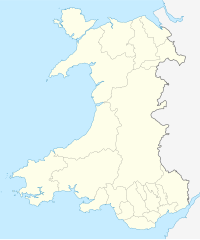The Defensible Barracks at Pembroke Dock, is a Grade II* listed, Victorian-era fortification and barracks in Pembrokeshire, South Wales. It is a 20-sided stone fort surrounded by a dry moat with masonry walls. A parade ground occupies the centre of the fort. It was built in the mid-1840s to house the Royal Marines based in Pembroke Dockyard and to protect the dockyard.
| Defensible Barracks, Pembroke Dock | |
|---|---|
| Pembroke Dock, Pembrokeshire | |
 Main Gate of the Defensible Barracks | |
| Coordinates | 51°41′20″N 4°57′03″W / 51.6889°N 4.9508°W |
| Grid reference | grid reference SM961031 |
| Type | Fort |
| Site information | |
| Open to the public | No |
| Site history | |
| Materials | Rubble stone |
Listed Building – Grade II* | |
History
editThe barracks was built between 1841 and 1846 to house the dockyard's garrison of Royal Marines and to cover the landward side of the dockyard from an infantry assault. It was probably the last trace bastion fort built in Europe.[1] Prior to the Defensible Barracks' construction, the Royal Marines were housed in the hulked 74-gun ship, HMS Dragon, that had been deliberately run aground in 1832.[2]
The barracks was acquired by a private developer, with plans to convert it into residential accommodation, in September 2019.[3] However, the property was for sale again in late 2022,[4] and as of January 2024 remains so.[5]
Description
editThe barracks is in the form of a square bastion trace with four two-storey, barracks ranges surrounding the central parade ground.[1] "The enclosed yard remains notable for being the finest Georgian-style square in Wales".[6] A fortified gatehouse is in the middle of the north wall. The moat is about 16 feet (4.9 m) deep and 42 feet (12.8 m) wide and is crossed by a fixed modern steel bridge that replaced the original wooden sliding drawbridge that leads to the gatehouse. The scarp or inner wall of the moat rises above the height of the platform to serve as a parapet with musketry loopholes, except at the salient angles of the bastions to allow the guns mounted on the bastions' platform to fire over the parapet. All but the southwestern bastion still have some gun mountings remaining. The external walls of the gatehouse and the barracks ranges are also loopholed, although some of these have been fitted with sash windows.[1]
Notes
edit- ^ a b c "Barracks Platform, Presely View (W Side), Pembroke Dock". British Listed Buildings. Retrieved 17 April 2016.
- ^ Phillips, p. 17
- ^ "Inside the abandoned Victorian barracks that dominates Pembroke Dock". Wales Online. 9 February 2020. Retrieved 12 April 2020.
- ^ "Pembroke Dock Defensible Barracks on market for £500,000". Western Telegraph. 12 November 2022. Retrieved 21 January 2024.
- ^ "Old Defensible Barracks". Strutt & Parker. Retrieved 21 January 2024.
- ^ Driver, Toby. "FORMER DEFENSIBLE BARRACKS;BARRACK HILL; PEMBROKE DOCKYARD". Coflein. Royal Commission on the Ancient and Historical Monuments of Wales.
Bibliography
edit- Phillips, Lawrie; Lieutenant Commander (2014). Pembroke Dockyard and the Old Navy: A Bicentennial History. Stroud, Gloucestershire, UK: The History Press. ISBN 978-0-7509-5214-9.
{{cite book}}: CS1 maint: multiple names: authors list (link)
